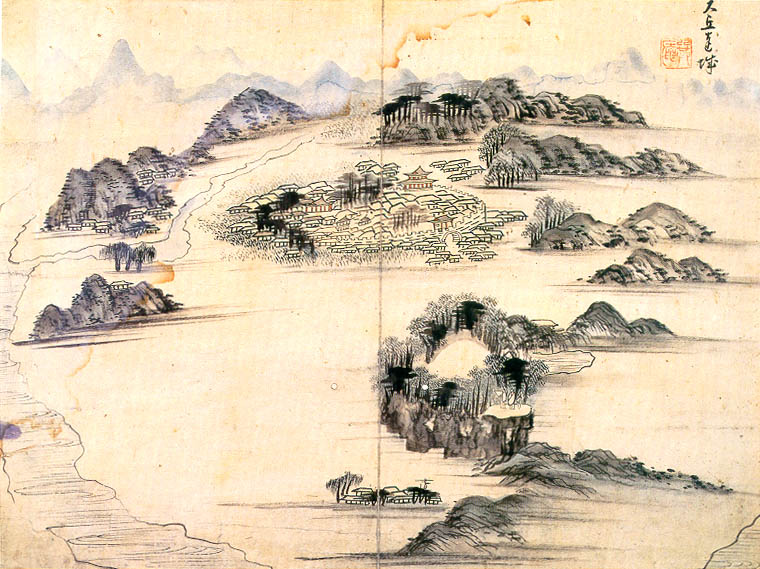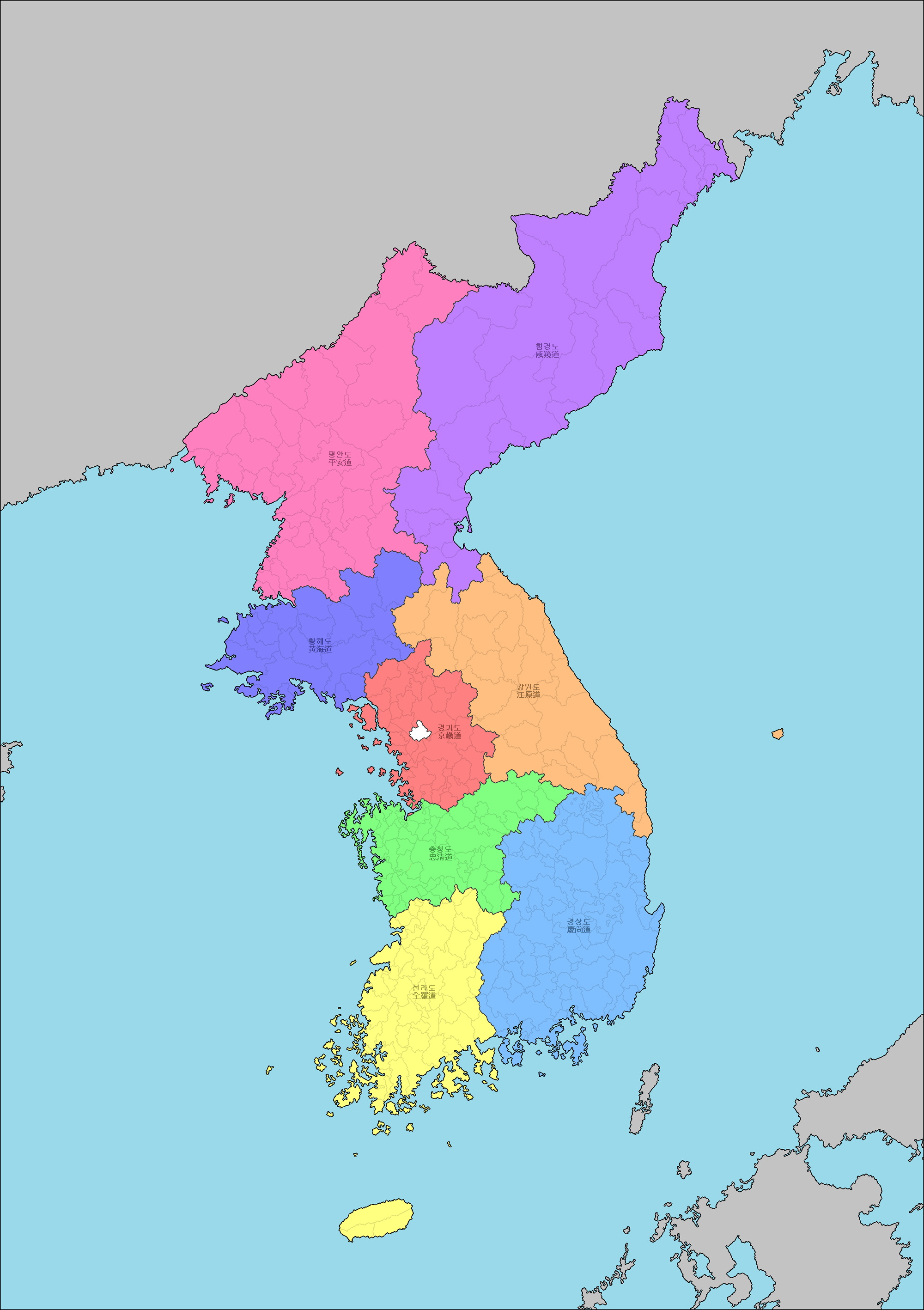|
Gyeongsang
Gyeongsang Province (; ) was one of the Eight Provinces of Joseon Korea. Gyeongsang was located in southeastern Korea. The provincial capital of Gyeongsang was Daegu. The region was the birthplace of the kingdom of Silla, which unified Korea in 668 CE. The region also has a highly significant role in modern Korean history; every non-acting South Korean president from 1963 to 2022 except Choi Kyu-hah (1979-1980) had ancestry from Gyeongsang, and all except Lee Myung-bak were also born in Gyeongsang. Today, the historical region is divided into five administrative divisions: the three independent cities of Busan, Daegu and Ulsan, and the two provinces of North Gyeongsang Province and South Gyeongsang Province. The largest city in the historical region is Busan, followed by Daegu. History The predecessor to Gyeongsang Province was formed during the Goryeo (918-1392), replacing the former provinces of Yeongnam, Sannam and Yeongdong. Gyeongsang acquired its current name in 1314. ... [...More Info...] [...Related Items...] OR: [Wikipedia] [Google] [Baidu] |
South Gyeongsang Province
South Gyeongsang Province (, ) is a province in the southeast of South Korea. The provincial capital is at Changwon. It is adjacent to the major metropolitan center and port of Busan. The UNESCO World Heritage Site Haeinsa, a Buddhist temple that houses the '' Tripitaka Koreana'' and tourist attraction, is located in this province. Automobile and petrochemical factories are largely concentrated along the southern part of the province, extending from Ulsan through Busan, Changwon, and Jinju. Etymology The name derives ; . The name derives from the names of the principal cities of Gyeongju () and Sangju (). History Joseon In 1407, for military purposes, the administrative districts were reorganized, with Gyeongsang-do being divided into Gyeongsangjwa-do (or Gyeongsangjwa Province; left) and Gyeongsangwu-do (or Gyeongsangwu Province; right) as the reference points of the Nakdonggang River. Before 1895, the area corresponding to modern-day South Gyeongsang Province was part of ... [...More Info...] [...Related Items...] OR: [Wikipedia] [Google] [Baidu] |
North Gyeongsang Province
North Gyeongsang Province (, ) is a province in eastern South Korea, and with an area of , it is the largest province in the Korean peninsula. The province was formed in 1896 from the northern half of the former Gyeongsang province, and remained a province of Korea (as Keishōhoku-dō during Japanese rule) until the country's division in 1945, then became part of South Korea. Daegu was the capital of North Gyeongsang Province between 1896 and 1981, but has not been a part of the province since 1981. In 2016, the provincial capital moved from Daegu to Andong. History The 1,000-year-old Silla Kingdom flourished and unified the previous three kingdoms. The area was named Gyeongsang-do in 1314 during the Goryeo Dynasty. In 1896, during the Joseon Dynasty, the area was renamed Gyeongsangbuk-do as 13 roads were reorganized. The current administrative district was reorganized with the reorganization of Bu, Gun, and Myeon in 1914. Geography and climate The province is part of the ... [...More Info...] [...Related Items...] OR: [Wikipedia] [Google] [Baidu] |
Provinces Of Korea
Korea has had administrative districts that can be considered provinces since the 7th century. These divisions were initially called ''ju'' () in Unified Silla and Later Baekje, and there were nine in total. After Goryeo conquered these states in the 10th century, twelve divisions called ''mok'' () were established, although they were reorganized into ten ''do'' () in the 11th century. After Joseon's conquest of Goryeo, it established the Eight Provinces of Korea, Eight Provinces in 1413. These provincial boundaries closely reflected major regions of Korea, regional and Korean dialects, dialect boundaries, and are still significant in contemporary Korea. In 1895, as part of the Gabo Reform, the country was redivided into 23 districts (''Bu;'' 부; ), which were replaced a year later by thirteen new provinces. The thirteen provinces of 1896 included three of the original eight provinces, with the five remaining original provinces divided into north and south halves (''Bukdo'' (북도 ... [...More Info...] [...Related Items...] OR: [Wikipedia] [Google] [Baidu] |
Gyeongsang Dialect
The Gyeongsang dialects (), also known as Southeastern Korean (), are dialects of the Korean language from the historical region of Gyeongsang Province. Today, that region is divided into Daegu, Busan, Ulsan, North Gyeongsang Province, and South Gyeongsang Province. Gyeongsang dialects vary. A native speaker can distinguish the dialect of Daegu from that of the Busan- Ulsan area although the first city is less than 100 kilometers away from the latter two cities. Dialectal forms are relatively similar along the midstream of Nakdong River but are different near Busan and Ulsan, Jinju and Pohang as well as along the eastern slopes of Mount Jiri. After Standard Korean, it is the next most prevalent Korean dialect. There are approximately 13,000,000 speakers. Vowels Most Gyeongsang dialects have six vowels, ''a'' (ㅏ), ''e'' (ㅔ), ''i'' (ㅣ), ''eo'' (ㅓ), ''o'' (ㅗ), ''u'' (ㅜ). In most areas, the vowelsㅐ(ae) and ㅔ (e) are conflated. A 2015 study found that Gyeo ... [...More Info...] [...Related Items...] OR: [Wikipedia] [Google] [Baidu] |
Daegu
Daegu (; ), formerly spelled Taegu and officially Daegu Metropolitan City (), is a city in southeastern South Korea. It is the third-largest urban agglomeration in South Korea after Seoul and Busan; the fourth-largest List of provincial-level cities of South Korea, metropolitan city in the nation with over 2.3 million residents; and the second-largest city after Busan in the Yeongnam Regions of Korea, region in southeastern South Korea. Daegu and the surrounding North Gyeongsang Province are often referred to as Daegu-Gyeongbuk, with a total population of over 5 million. Daegu is located in south-eastern Korea about from the coast, near the Geumho River and its mainstream, Nakdong River in Gyeongsang Province. The Daegu basin is the central plain of the Yeongnam List of regions of Korea, region. In ancient times, the Daegu area was part of the proto-kingdom Jinhan. Subsequently, Daegu came under the control of the Silla Kingdom, which unified the Korean Peninsula. During th ... [...More Info...] [...Related Items...] OR: [Wikipedia] [Google] [Baidu] |
Dialects Of Korean
A number of Korean dialects are spoken in Korea and by the Korean diaspora. The peninsula is very mountainous and each dialect's "territory" corresponds closely to the natural boundaries between different geographical regions of Korea. Most of the dialects are named for one of the traditional Eight Provinces of Korea. In the Korean language, only the Jeju dialect is considered sufficiently distinct to be regarded as a separate language. Dialect areas Korea is a mountainous country, and this could be the main reason why Korean is divided into numerous small local dialects. There are few clear demarcations, so dialect classification is necessarily to some extent arbitrary and based on the traditional provinces. A common classification, originally introduced by Shinpei Ogura in 1944 and adjusted by later authors, identifies six dialect areas: ; Hamgyŏng (Northeastern) :Spoken in the Hamgyong Province (Kwanbuk and Kwannam) region, the northeast corner of Pyongan Province, and ... [...More Info...] [...Related Items...] OR: [Wikipedia] [Google] [Baidu] |
Gyeongju
Gyeongju (, ), historically known as Seorabeol (, ), is a coastal city in the far southeastern corner of North Gyeongsang Province, South Korea. It is the second largest city by area in the province after Andong, covering with a population of 264,091 people . Gyeongju is southeast of Seoul, and east of Daegu. The city borders Cheongdo and Yeongcheon to the west, Ulsan to the south and Pohang to the north, while to the east lies the coast of the Sea of Japan. Numerous low mountains—outliers of the Taebaek Mountains, Taebaek range—are scattered around the city. Gyeongju was the capital of the ancient kingdom of Silla (57 BC – 935 AD), which ruled about two-thirds of the Korean peninsula at its height between the 7th and 9th centuries, for close to one thousand years. Later Silla was a prosperous and wealthy country, and Gyeongju was the fourth largest city in the world. A vast number of archaeological sites and cultural properties from this period remain in the city. Gye ... [...More Info...] [...Related Items...] OR: [Wikipedia] [Google] [Baidu] |
Eight Provinces Of Korea
During most of the Joseon dynasty, Korea was divided into eight provinces ('' do''; ). The eight provinces' boundaries remained unchanged for about 480 years from 1413 to 1895, and formed a geographic paradigm that is still reflected today in the Korean Peninsula's administrative divisions, dialects, and regional distinctions. The names of all eight provinces are still preserved today, in one form or another. These eight historical provinces form both North and South Korea, and are not to be confused with the provinces that make up North Korea or South Korea. History Provinces before 1895 In 1413 (the 13th year of the reign of King Jeongjong), the north-eastern boundary of Korea was extended to the Tumen River. The country was reorganized into eight provinces: Chungcheong, Gangwon, Gyeonggi, Gyeongsang, Jeolla, P'unghae (renamed Hwanghae in 1417), P'yŏngan, and Yŏnggil (eventually renamed Hamgyŏng in 1509). Districts of 1895–96 For almost 500 years, the ei ... [...More Info...] [...Related Items...] OR: [Wikipedia] [Google] [Baidu] |
Busan
Busan (), officially Busan Metropolitan City, is South Korea's second list of cities in South Korea by population, most populous city after Seoul, with a population of over 3.3 million as of 2024. Formerly romanized as Pusan, it is the economic, cultural and educational center of southeastern South Korea, with its port being South Korea's busiest and the sixth-busiest in the world. The surrounding "Southeastern Maritime Industrial Region" (including Ulsan, South Gyeongsang Province, South Gyeongsang, Daegu, and part of North Gyeongsang Province, North Gyeongsang and South Jeolla Province, South Jeolla) is South Korea's largest industrial area. The large volumes of port traffic and urban population in excess of 1 million make Busan a Large-Port metropolis using the Southampton System of Port-City classification. As of 2019, Busan Port is the primary port in Korea and the world's sixth-largest container port. Busan is divided into 15 major administrative districts and a single co ... [...More Info...] [...Related Items...] OR: [Wikipedia] [Google] [Baidu] |
Sangju
Sangju (; ) is a Administrative divisions of South Korea, city in North Gyeongsang Province, South Korea. Although Sangju is rather rural, it is very old and was once a key city. Along with Gyeongju, it gives rise to half of the name of the Gyeongsang Provinces. Sangju is nicknamed ''Sam Baek'', or "Three Whites", referring to three prominent agricultural products rice, silkworm cocoon (silk), cocoons, and dried persimmons from the area. Geography and climate Geography Sangju lies on the northwestern border of North Gyeongsang province, touching on North Chungcheong Province. Thus, to its west and north it adjoins the North Chungcheong counties of Boeun County, Boeun, Goesan County, Goesan, Okcheon County, Okcheon, and Yeongdong County, Yeongdong. Within North Gyeongsang province, it touches Mungyeong on the north, Yecheon County, Yecheon, Uiseong County, Uiseong, and Gumi, South Korea, Gumi on the east, and Gimcheon to the south. The north and west extremes of the city are fo ... [...More Info...] [...Related Items...] OR: [Wikipedia] [Google] [Baidu] |




